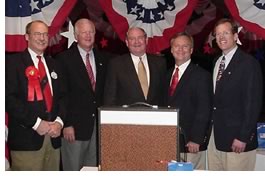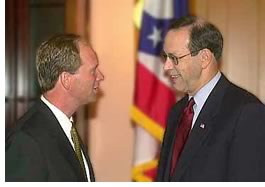

Associate Editor
With election campaigns heating up this fall, architects are among those who have entered the political fray. State representatives from Arkansas, Florida, Georgia, and Ohio are working to convince voters to return them to their elected posts, while a architect in Maryland is seeking to take the oath of office for the first time come inauguration day.
 At
least five architects are running for seats in their state legislature.
They are:
At
least five architects are running for seats in their state legislature.
They are:
• Sen. Charles Clary, FAIA, (R) Majority Whip, Florida Senate (running
unopposed)
• Eric Johnson, AIA, (R) Senate Minority Leader, Georgia House of
Representatives
• Robert J. Smith, AIA, (R) candidate for Maryland House, AIA Maryland
president-elect
• Chris Widener, FAIA, (R) former Ohio state representative, former
vice chair of the PIA Council and former chair, AIA Documents Committee
• Rep. Thomas Moore (D), Arkansas House of Representatives.
These are not the architects' first forays into politics. Each of the designers has served at the local level on a wide range of community boards, school boards, and at the local and state levels of the AIA.
 Widener,
president of Widener-Reichard Design & Construction, Springfield,
Ohio, is president of AIA Ohio; Smith, partner, Smith Colen Architects,
Gaithersburg, Md., is president-elect of the Maryland Society of the AIA;
Clary, has received a Component Excellence Award for his contributions
to Florida's government and industry affairs program; Johnson, the Georgia
Senate minority leader, has served in Georgia's General Assembly since
1993.
Widener,
president of Widener-Reichard Design & Construction, Springfield,
Ohio, is president of AIA Ohio; Smith, partner, Smith Colen Architects,
Gaithersburg, Md., is president-elect of the Maryland Society of the AIA;
Clary, has received a Component Excellence Award for his contributions
to Florida's government and industry affairs program; Johnson, the Georgia
Senate minority leader, has served in Georgia's General Assembly since
1993.
The architect candidates are well versed on the AIA's legislative priorities: the safety and security of building structures, homeland security, "smart growth" issues, taxes on professional services, continuing education provisions, licensure, building codes, and tort reform. Widener called attention to the fact that Ohio, like all states across the nation, is looking at taxing professional services in an effort to bridge the budgetary gap between declining revenues and expenditures.
Through firsthand experience, every one of these AIA members views elected office as an opportunity to use the skills they have honed through their education and practice to serve the people of their communities.
"What we do as architects lends itself well to public policy," Johnson said. "Architects have to design buildings within budgets; politicians have to work within a budget. There is never enough money for everything you want to do, and there is a lot of compromising, negotiating, and management of priorities." The Georgia Republican is a member of the Appropriations, Finance and Public Utilities, Rules, and Transportation committees.
"I think it's our responsibility to get involved in local and state politics," said Clary, who is the first architect to serve in the Florida Senate. "Because of the training that architects go through and the fact that we tend to be leaders in a decision-making process, I think we are trained in a way that could benefit the political process. Our whole education and training develops in us a methodology of defining and solving problems. And so much of what our various specialties touch on—education, for instance, or development—is important to community growth management. That expertise is valuable. I think it's critical. It's incumbent upon us as architects to be leaders in the community, whether it be on a planning commission, city council, or county commission."
Political and business exposure
Some architects, the politicians note, worry about the effect holding
elected office will have on their businesses. Nonetheless, Clary said,
the "overall benefits and rewards outweigh the losses."
"I've found you take yourself out of some opportunities to do architectural work," Clary said. "I probably had to step down or step away from as many jobs as the firm has taken on in the last six years. When you're in this position, you meet so many more people, so there are a lot of new doors to open. But at the same time, because of potential conflicts, you have to step away from certain jobs."
Widener also noted some tangible benefits for his practice. "Once in political life, the positive name identification, spending money in political campaigns, yard signs, and radio and newspaper print ads builds name recognition," he noted. "This is good for an architecture firm."
"Even though I thought I knew a lot of people in the three-county area," Widener said, "I came to realize that I didn't hardly know anyone. . . . When you get to this type of position where you're out and meeting community leaders in every community, the business leaders, the people who do physical-plant projects for the private or public sector, we're in contact with them, and that's very positive for marketing and name recognition, too."
Widener explained that his legislative position generally precluded him by state rule from working for the state, but said his other clients "value the experience that we can bring to the table as architects by knowing the process that they go through."
 Two
full-time jobs
Two
full-time jobs
Candidate Smith of Gaithersburg, Md., answered his own phone as he prepared
some architecture drawings one Friday evening. For Smith, who won his
first Republican primary fight after two previous tries, politics has
been a lifelong pursuit. However, he said, maintaining a full-time architecture
practice was often a "juggling act," and noted that it helps
greatly to have the support and assistance of his family and backers,
including some Maryland architects.
Johnson advised that public service, while rewarding, cuts into professional time. "I've been lucky to be in a larger firm and in a management-level position," Johnson said. "I'm not sitting at the CAD drawing, I'm serving more as the principal in charge and making sure everyone is meeting their deadlines." He said it is more difficult for a small practitioner. He suggested that anyone interested in political office can start out by serving on the school board, city council, or county commission, as long as "they're willing to do the work when they can do the work."
It has to be a very methodical planning of how you can prepare yourself to take on these roles, Clary said. Among his supporters were AIA Florida and its PAC.
Widener, who spoke for this article from his car, echoed Johnson's and Clary's sentiments. "I'm on my way to the AIA Ohio convention, and my wife is driving so I can be on the phone making calls back to the office to run architecture projects and fund-raising calls to raise the money it takes to run a political campaign. There's not a spare moment in the day. It certainly helps to have some ability to manage time. Nobody's perfect, but you have to be able to do just about all of it."
What does it take?
"Are you a people person? Do you like to meet people and sympathize
and understand?" These are two questions Johnson recommended asking
yourself if you are considering a run for political office. "Some
people don't have that personality. But if you do, then I think you should
consider public service." And keep in mind the time commitment, he
advised. "I'm in the position where I have to leave town for a couple
of months a year." But serving on a city council, county commission,
or the school board is something any architect can do, he said.
Widener said many architects discount the name recognition they enjoy in their community due to their "public-type" projects. And that name recognition can help overcome one of the greatest hurdles of gaining public office. Even with the time, interest, and skills to get on the ballot, he said, it comes down to fundraising. "You have to be able to raise quite a bit of money, about $100,000 to $150,000 for a local house race in Ohio every two years. Some architects just don't have the stomach for that." On the other hand, he said, "architects who have been involved in private community fundraisers excel at that kind of thing. If you put all those things together, then you probably have a good combination that probably works well for political life."
Copyright 2002 The American Institute of Architects. All rights reserved.
![]()
|
Click here to read about Charlie Clary's experiences as a practioner and politician. Click here to visit Sen. Eric Johnson's campaign Web site. Click here to visit Robert J. Smith's campaign Web site. Click here to visit Chris Widener's Web site. If you or anyone you know is running for legislative office, please let our Government Affairs team know. |
|